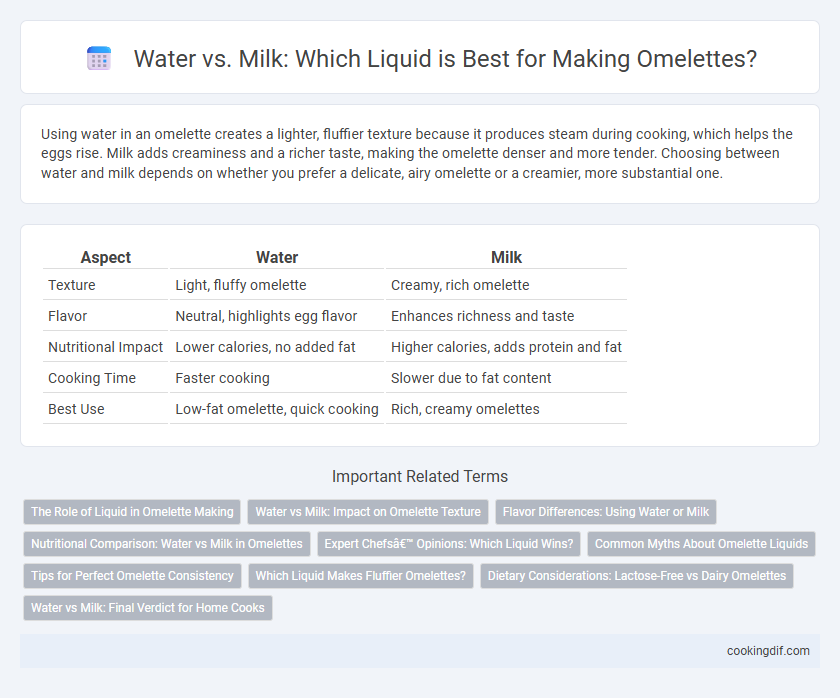Using water in an omelette creates a lighter, fluffier texture because it produces steam during cooking, which helps the eggs rise. Milk adds creaminess and a richer taste, making the omelette denser and more tender. Choosing between water and milk depends on whether you prefer a delicate, airy omelette or a creamier, more substantial one.
Table of Comparison
| Aspect | Water | Milk |
|---|---|---|
| Texture | Light, fluffy omelette | Creamy, rich omelette |
| Flavor | Neutral, highlights egg flavor | Enhances richness and taste |
| Nutritional Impact | Lower calories, no added fat | Higher calories, adds protein and fat |
| Cooking Time | Faster cooking | Slower due to fat content |
| Best Use | Low-fat omelette, quick cooking | Rich, creamy omelettes |
The Role of Liquid in Omelette Making
The role of liquid in omelette making is crucial for texture and fluffiness, with water and milk serving different purposes. Water creates steam during cooking, resulting in a lighter, airier omelette, while milk contributes to a creamier and richer consistency due to its fat content. Selecting the appropriate liquid affects the omelette's moisture, tenderness, and overall mouthfeel, influencing the final culinary experience.
Water vs Milk: Impact on Omelette Texture
Using water in omelette preparation results in a lighter, fluffier texture due to steam expansion during cooking, while milk adds creaminess and a denser, richer consistency because of its fat and protein content. Water-based omelettes tend to be more tender and delicate, whereas milk-based versions offer a smoother mouthfeel and enhanced flavor complexity. Balancing water and milk proportions can optimize moisture and texture, catering to individual taste preferences.
Flavor Differences: Using Water or Milk
Milk enhances an omelette's flavor by adding richness and creaminess, creating a softer texture and a slightly sweeter taste. Water results in a lighter, fluffier omelette with a more delicate flavor, allowing the egg's natural taste to stand out. Choosing milk or water impacts the overall mouthfeel, with milk providing a denser, more velvety consistency, while water keeps the omelette airy and less heavy.
Nutritional Comparison: Water vs Milk in Omelettes
Milk adds protein, calcium, and vitamins like B12 and D to omelettes, enhancing their nutritional profile, while water contributes no calories or nutrients. Using milk increases the fat content and overall calories, which may be beneficial for those seeking additional energy and nutrients. Water keeps the omelette lighter and lower in calories, ideal for calorie-conscious individuals.
Expert Chefs’ Opinions: Which Liquid Wins?
Expert chefs often prefer water over milk for omelette preparation due to its ability to create a lighter, fluffier texture by generating steam during cooking. Milk can add richness and a slightly denser consistency but may weigh down the omelette, making it less tender. Culinary professionals prioritize water when aiming for a delicate, airy omelette, while milk is favored for a creamier, more substantial taste.
Common Myths About Omelette Liquids
Many believe water makes omelettes fluffier due to steam generation, but milk's fat content actually enhances creaminess and texture. Using milk adds richness and a tender bite, while water can produce a lighter omelette with slightly less flavor. The choice between water and milk depends on desired texture rather than a strict rule of quality.
Tips for Perfect Omelette Consistency
Using water in an omelette creates a lighter, fluffier texture by producing steam during cooking, which helps lift and aerate the eggs. Milk adds creaminess and a richer taste but can make the omelette denser and less airy. For the perfect omelette consistency, use cold water for a tender, cloud-like texture or a splash of milk to achieve a soft, custard-like interior.
Which Liquid Makes Fluffier Omelettes?
Using water instead of milk in omelettes creates steam during cooking, leading to a lighter, fluffier texture due to the expansion of water molecules. Milk adds creaminess and richness but tends to produce a denser, moister omelette because of its fat content. For the fluffiest omelettes, incorporating water is generally preferred as it enhances aeration without weighing down the eggs.
Dietary Considerations: Lactose-Free vs Dairy Omelettes
Using water instead of milk in omelettes creates a lactose-free option suitable for individuals with lactose intolerance or dairy allergies. Water-based omelettes have a lighter texture and reduce calorie content, benefiting those monitoring fat intake. Milk-based omelettes provide added creaminess and nutrients like calcium but may cause digestive issues for sensitive individuals.
Water vs Milk: Final Verdict for Home Cooks
Water creates a lighter, fluffier omelette by generating steam during cooking, while milk adds richness and a creamier texture but can make the omelette denser. Home cooks seeking a delicate and airy omelette should choose water, whereas those preferring a custard-like consistency benefit from using milk. The final decision depends on desired texture and flavor preferences, with water favored for simplicity and milk for indulgence.
Water vs milk for omelette liquid Infographic

 cookingdif.com
cookingdif.com